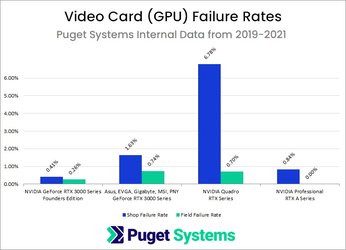Every single brand had some problems with the quality of at least a single product, but some brands repeat the same mistakes for years. I remember when ASUS HD7970 Matrix was dying because of design flaws. I sent 2 of them to RMA and sold the last replacement. You would expect it's the top quality card.
I see it like this:
- Sapphire - makes probably the most reliable AMD cards, but their availability has been limited in recent years. In the last years (~3 years or something), fans can be sent separately to RMA without removing the cooler.
- XFX/HIS - both brands are one nowadays, and both had big problems with the quality of some series. I remember mixed memory IC, too relaxed timings, problems with coolers, overheating, and problems with PCB design. On top of that, I had one review sample which was supposed to be a retail product, and it was soldered/covered with paint. Later I got info that the whole batch had design flaws, and they manually corrected that. The last 2 XFX generations are much better, with pretty good and quiet coolers and better power design (I tested at least five different cards), so I assume they made big changes, and hopefully, it will improve. Just to add something, the current XFX is not the same brand as it was 5+ years ago.
- PowerColor - some cards are great, like the Red Dragon / Red Devil series. Some lower cards are clearly not the best and have some design flaws. There were repeatable cooler issues in some series. However, most of their sales are in Asia, and not all models are available in the EU/US.
- MSI - some cards are great, and some are mediocre. I mean, you can get a card with good PCB/VRM but below average cooler. Power limits are usually lower than on competitive cards, even lower than reference. Often, they design cheaper power designs or cheaper coolers for the most popular cards. They used to have better cards compared to the competition.
- Gigabyte - the same as MSI; some cards are great, and some cards are below the average. They release many models, some not much cheaper and have worse coolers like fewer heat pipes, no copper cold plate, and some more. Many cards have problems with coolers. Most problems are related to the most popular and cheaper models.
- ASRock - pretty good high-end models, just average everything else. It's not a popular graphics card brand, and hard to find them in many countries, so there is also not much feedback about quality. I have one, and it's great, but the design is a bit weird.
- ASUS - most cards are high quality, so I could say it's the best option if you pick Nvidia. Some models had single problems, but they didn't repeat the same issues later.
- Palit/Gainward - the same brand, almost everything pretty average quality. Low price, but when you compare it to other brands, you know why. Everything has warranty stickers - no sticker = no warranty.
- PNY - the same as Palit/Gainward
- Galax - I have mixed feelings about this brand. Top OC series seem great, but my HoF cards were whistling under load so loud that after tests, I sold them as I couldn't stand it.
- Colorful - some cards look interesting, but they sell them almost only in Asia and barely ever send any review samples, so I had no chance to check them.
Maybe I missed something.
In short, for me, ASUS is a choice for AMD and Nvidia. Sapphire is a choice for AMD. Everything else depends on a specific model.

